1988 PONTIAC FIERO sensor
[x] Cancel search: sensorPage 620 of 1825
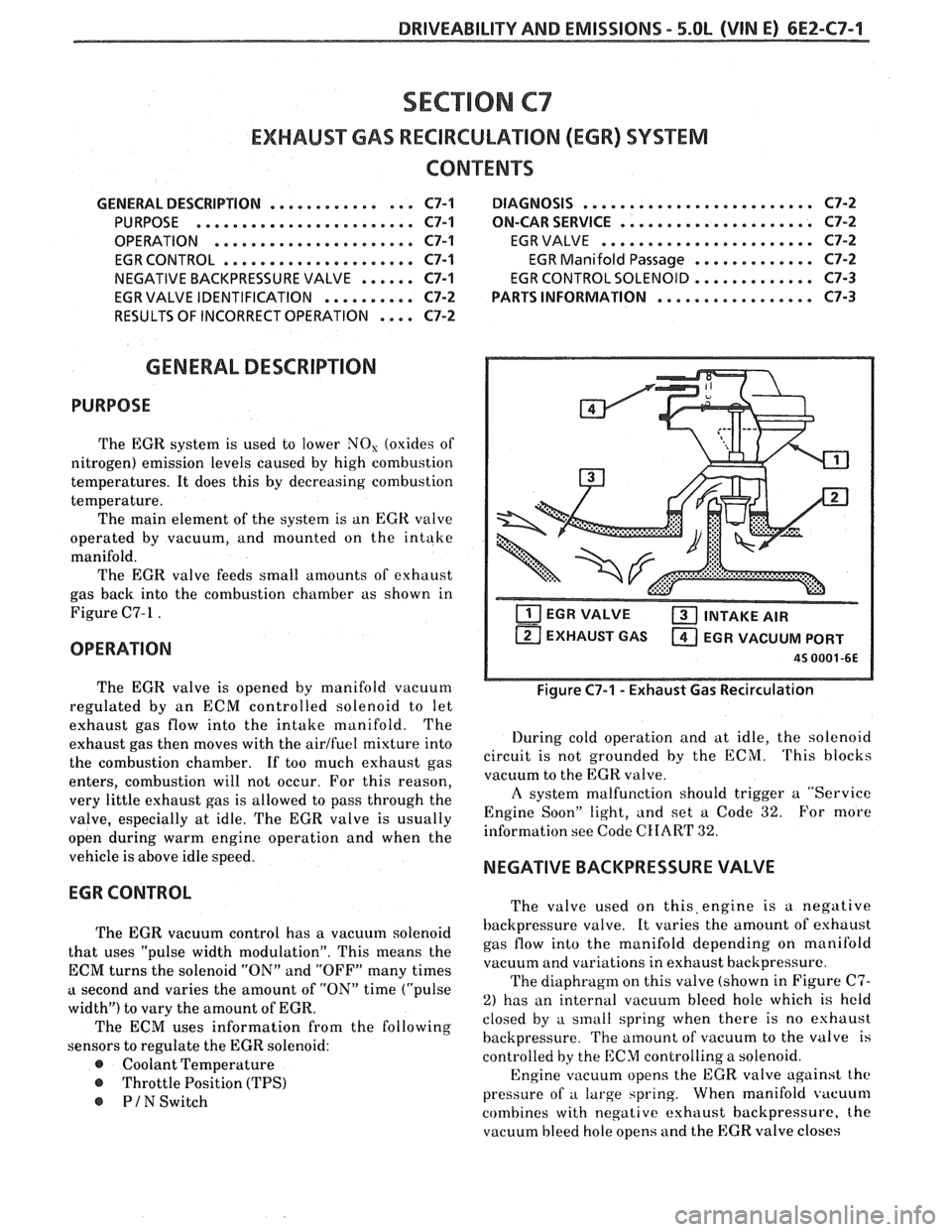
DRIVEABILITY AND EMISSIONS - 5.OL (VIN E) 6E2-C7-1
SECTION C7
EXHAUST GAS RECIRCULAVON (EGR) SYSEENO
GENERAL DESCRIPTION ...............
........................ PURPOSE
OPERATION
......................
EGR CONTROL .....................
...... NEGATIVE BACKPRESSURE VALVE
.......... EGR VALVE IDENTIFICATION
RESULTS OF INCORRECT OPERATION
. . , .
CONTENTS
......................... C7-1 DIAGNOSIS C7-2
..................... C7-1 ON-CAR SERVICE C7-2
....................... C7-1 EGRVALVE C7-2
............. C7-1 EGR Manifold Passage C7-2
C7-1
EGR CONTROL SOLENOID ............. C7-3
C7-2 PARTS INFORMATION
................. C7-3
C7-2
GENERAL DESCRIPTION
PURPOSE
The EGR system is used to lower NO, (oxides of
nitrogen) emission levels caused by high combustion
temperatures.
It does this by decreasing combustion
temperature. The main element of the system is an
EGR valve
operated by vacuum, and mounted on the intake
manifold. The EGR valve feeds small amounts of exhaust
gas back into the combustion chamber as shown in
Figure C7-1
.
OPERATION
The EGR valve is opened by manifold vacuum
regulated by an ECM controlled solenoid to let
exhaust gas flow into the intake manifold. The
exhaust gas then moves with the
airlfuel mixture into
the combustion chamber.
If too much exhaust gas
enters, combustion will not occur. For this reason,
very little exhaust gas is allowed to pass through the
valve, especially at idle. The EGR valve is usually
open during warm engine operation and when the
vehicle is above idle speed.
EGR CONTROL
The EGR vacuum control has a vacuum solenoid
that uses "pulse width modulation". This means the
ECM turns the solenoid "ON" and "OFF" many times
a second and varies the amount of "ON" time ("pulse
width") to vary the amount of EGR.
The ECM uses information from the following
sensors to regulate the EGR solenoid:
@ Coolant Temperature
@ Throttle Position (TPS)
PIN Switch
T'IT] EGR VALVE a INTAKE AIR
EXHAUST GAS
a EGR VACUUM PORT
45 0001 -6E
Figure C7-1 - Exhaust Gas Recirculation
During cold operation and at idle, the solenoid
circuit is not grounded by the ECM.
'I'his blocks
vacuum to the EGR valve.
A system malfunction should trigger a "Service
Engine Soon" light, and set a Code
32. For more
information see Code
CHAR'I' 32.
NEGATIVE BACKPRESSURE VALVE
The valve used on this,engine is a negative
backpressure valve. It varies the amount of eshaust
gas flow into the manifold depending on manifold
vacuum and variations in exhaust backpressure.
The diaphragm on this valve (shown in Figure
C7-
2) has an internal vacuum bleed hole which is held
closed by a sinall spring when there is no eshaust
backpressure.
The amount of vacuum to the valve is
controlled
by the ECM controlling a solenoid.
Engine vacuum opens the EGR valve against
the
pressure of a large spring. When manifold vacuum
combines with negative exhaust backpressure, the
vacuum bleed hole opens and the EGR valve closes
Page 626 of 1825
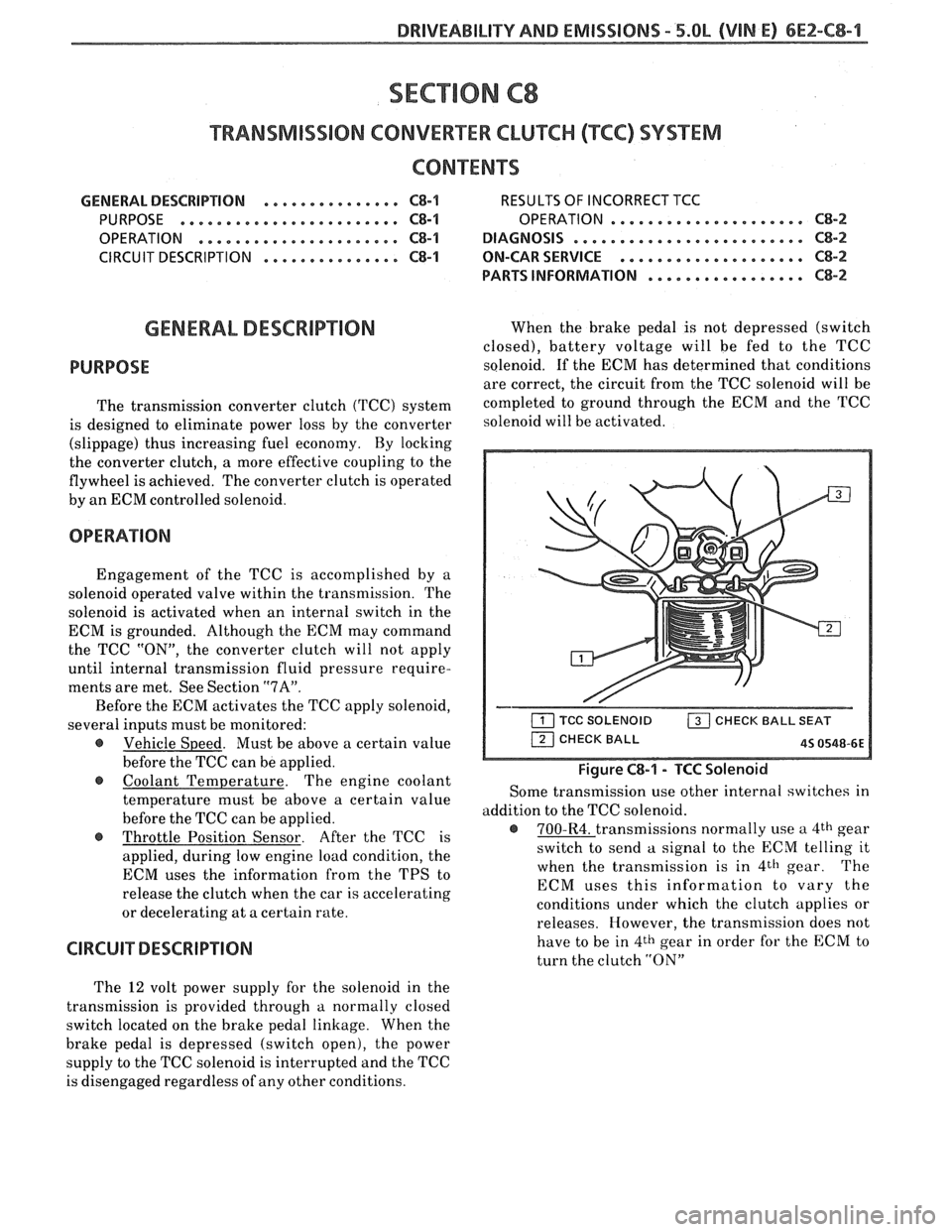
DRIVEABILITY AND EMISSIONS - 5.0L (VIM E) 6E2-C8-1
SECTION C8
"FRANSMISSIBN CONVERnEW CLUTCH (TCC) SYSTEM
CONTENTS
GENERAL DESCRIPTION ............... C8-1 RESULTS OF INCORRECT TCC
PURPOSE
........................ C8-1 OPERATION ..................... C8-2
......................... OPERATION ...................... C8-1 DIAGNOSIS CS-2
.................... CIRCUIT DESCRIPTION ....e.e..eea..e C8-1 ON-CAR SERVICE C8-2
................. PARTS INFORMATION C8-2
GENERAL DESCRIPTION
PURPOSE
The transmission converter clutch (TCC) system
is designed to eliminate power loss by the converter
(slippage) thus increasing fuel economy. By locking
the converter clutch,
a more effective coupling to the
flywheel is achieved. The converter clutch is operated
by an ECM controlled solenoid.
OPERATION
Engagement of the TCC is accomplished by a
solenoid operated valve within the transmission. The
solenoid is activated when an internal switch in the
ECM is grounded. Although the ECM may command
the TCC
"ON", the converter clutch will not apply
until internal transmission fluid pressure require-
ments are met. See Section
"7A".
Before the ECM activates the TCC apply solenoid,
several inputs must be monitored:
e Vehicle Speed. Must be above a certain value
before the TCC can be applied.
Coolant Temperature. The engine coolant
temperature must be above a certain value
before the TCC can be applied.
@ Throttle Position Sensor. After the TCC is
applied, during low engine load condition, the
ECM uses the information from the TPS to
release the clutch when the car is accelerating
or decelerating at a certain rate.
CIRCUIT DESCRIPTION
When the brake pedal is not depressed (switch
closed), battery voltage will be fed to the TCC
solenoid. If the ECM has determined that conditions
are correct, the circuit from the TCC solenoid will be
completed to ground through the ECM and the TCC
solenoid will be activated.
Figure C8-1 - TCC Solenoid
Some transmission use other internal switches in
addition to the TCC solenoid.
@ 700-R4. transmissions normally use a 4th gear
switch to send
a signal to the ECM telling it
when the transmission is in
4th gear. The
ECM uses this information to vary the
conditions under which the clutch applies or
releases. However, the transmission does not
have to be in
4th gear in order for the ECM to
turn the clutch
"ON"
The 12 volt power supply for the solenoid in the
transmission is provided through
a normally closed
switch located on the brake pedal linkage. When the
brake pedal is depressed (switch open), the power
supply to the TCC solenoid is interrupted and the TCC
is disengaged regardless of any other conditions.
Page 627 of 1825
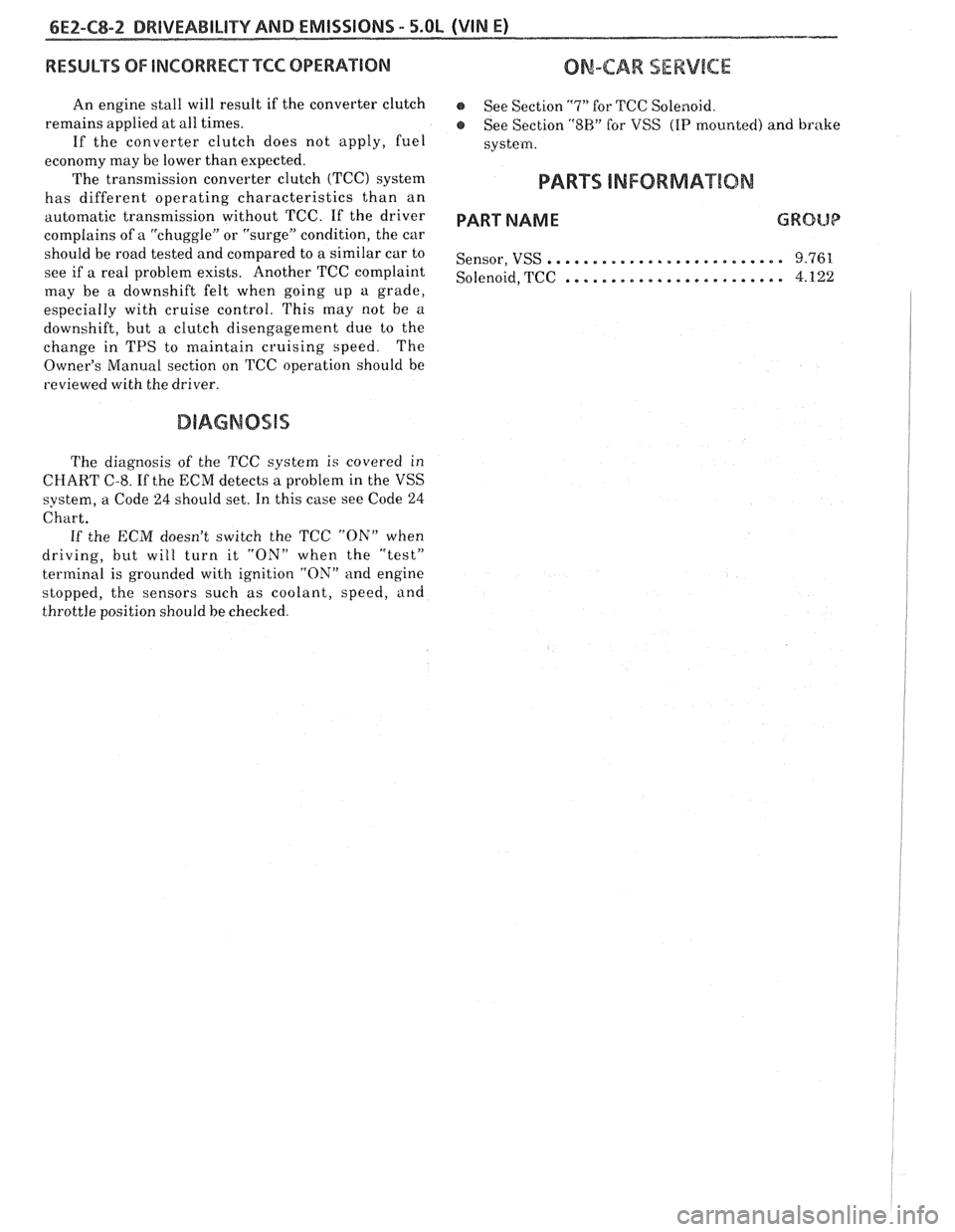
6Ef-C8-2 BRlVEABlLlYV AND EMISSIONS - 5.OL (VIN E) ----
RESULTS OF INCORRECTTCC OPERATION
An engine stall will result if the converter clutch
remains applied at all times.
If the converter clutch does not apply, fuel
economy may be lower than expected.
The transmission converter clutch
(TCC) system
has different operating characteristics than an
automatic transmission without TCC.
If the driver
complains of a "chuggle" or "surge" condition, the car
should be road tested and compared to a similar car to
see if a real problem exists. Another TCC complaint
may be
a downshift felt when going up a grade,
especially with cruise control. This may not be
a
downshift, but a clutch disengagement due to the
change in TPS to maintain cruising speed. The
Owner's Manual section on TCC operation should be
reviewed with the driver.
DIAGNOSIS
The diagnosis of the TCC system is covered in
ClIART C-8. If the ECM detects a problem in the VSS
system, a Code
24 should set. In this case see Code 24
Chart.
If the ECM doesn't switch the TCC "ON" when
driving, but will turn it
"ON" when the "test"
terminal is grounded with ignition "ON" and engine
stopped, the sensors such as coolant, speed, and
throttle position should be checked.
ON-CAW SERVICE
@ See Section "7" for TCC Solenoid.
@ See Section "SH" for VSS (HP mounted) and brake
system.
PAR- SNFORMATBIQN
PART NAME GRQUQ
.......................... Sensor, VSS 9.761
........................ Solenoid, TCC 4.122
Page 629 of 1825

6EZ-C8-4 DRIVEABILITY AND EMISSIONS - 5.OL (VIN E)
I5 WAY (FRONT VIEW)
SPEED INPUT
4rH GEAR SIGNAL
422 TANIBLK
ALDL CONNECTOR
CHART C-8A
TRANSMISSION CONVERTER CLUTCH (TCC)
ELECTRICAL DIAGNOSIS
(Page 1 of 2)
5.OL (VIN E) "F" "SERIES (TBI)
Circuit Description:
The purpose of the automatic transmission torque converter clutch is to eliminate the power loss of the
torque converter, when the vehicle is in a cruise condition. This allows the convenience of the automatic
transmission and the fuel economy of a manual transmission.
Fused battery ignition is supplied to the TCC solenoid through the brake switch. the ECM will engage
TCC
by grounding CKT 422 to energize the solenoid.
TCC will engage when:
- Vehicle speed above 24 mph - Engine at normal operating temperature (above 70°C, 156°F)
- Throttle position sensor output not changing, indicating a steady road speed
- Brake switch closed
Test Description: Numbers below refer to circled solenoids
and relays before installing a
numbers on the diagnostic chart. replacement ECM. Replace
any solenoid or relay
1. Confirms 12 volt supply as well as continuity of that
measures less than 20 ohms.
TCC circuit.
2. Grounding the diagnostic terminal with engine Diagnostic Aids:
"OFF", should energize the capability of the ECM An
engine coolant thermostat that is stuck open or
to control the solenoid. opens
at too low a temperature, may result in an
3. Solenoid coil resistance must measure more than inoperative TCC.
20 ohms. Less resistance will cause early failure
of the ECM
drive^.". Using an ohmmeter, check
the solenoid coil resistance of
all ECM controlled
Page 638 of 1825
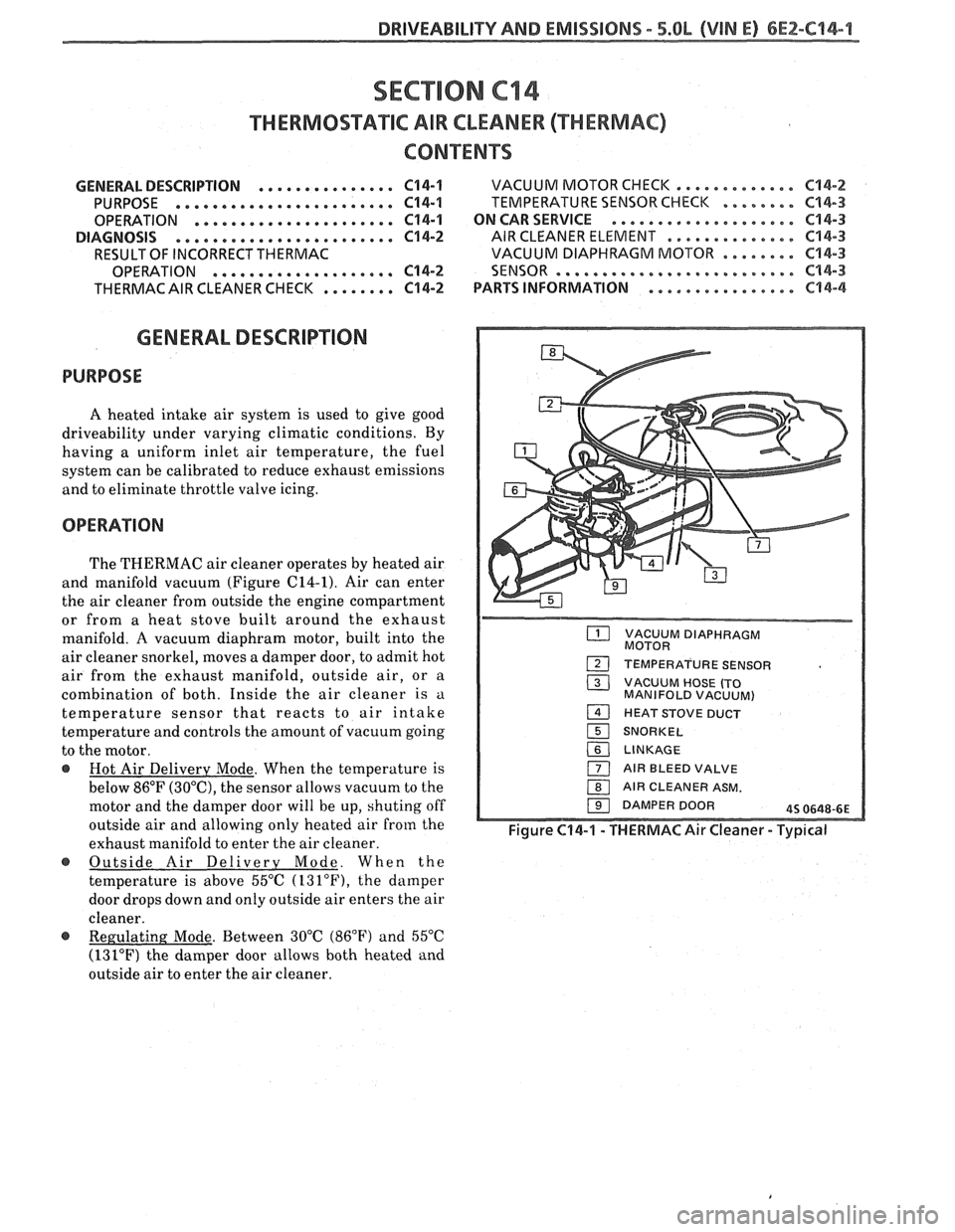
DRIVEABILITY AND EMISSIONS - S.OL (VIN El 6EZ-C44-1
SECTION C14
"FHERMOSTATlC AIR CLEANER (THERMAC)
CONTENTS
GENERAL DESCRIPTION ............... C14-1 VACUUM MOTORCHECK ............. C14-2
PURPOSE ........................ C14-1 TEMPERATURE SENSOR CHECK ........ 614-3
.................... OPERATION ...................... C14-1 ON CAR SERVICE C14-3
DIAGNOSIS ...e..oe........e.ee.~.. C14-2 AIRCLEANER ELEMENT .............. Cl4-3
RESULT OF INCORRECT THERMAC VACUUM
DIAPHRAGM MOTOR ........ 614-3
.................... OPERATION C14-2
SENSOR .......................... 614-3
THERMACAIR CLEANER CHECK ........ C14-2 PARTS INFORMATION ................ C14-4
GENERAL DESCRIPmION
PURPOSE
A heated intake air system is used to give good
driveability under varying climatic conditions. By
having a uniform inlet air temperature, the fuel
system can be calibrated to reduce exhaust emissions
and to eliminate throttle valve icing.
OPERATION
The THERMAC air cleaner operates by heated air
and manifold vacuum (Figure C14-1). Air can enter
the air cleaner from outside the engine compartment
or from a heat stove built around the exhaust
manifold.
A vacuum diaphram motor, built into the
air cleaner snorkel, moves a damper door, to admit hot
air from the exhaust manifold, outside air, or
a
combination of both. Inside the air cleaner is a
temperature sensor that reacts to air intake
temperature and controls the amount of vacuum going
to the motor.
@ Hot Air Delivery Mode. When the temperature is
below
86°F (30°C), the sensor allows vacuum to the
motor and the damper door will be up, shuting off
outside air and allowing only heated air
from the
exhaust manifold to enter the air cleaner.
@ Outside Air Delivery Mode. When the
temperature is above 55°C
(131°F), the damper
door drops down and only outside air enters the air
cleaner.
VACUUM DIAPHRAGM
MOTOR
TEMPERATURE SENSOR
( VACUUM HOSE (TO
MANIFOLD VACUUM)
1 HEAT STOVE DUCT
151 SNORKEL
16( LINKAGE
1 AIR BLEED VALVE
1 AIR CLEANER ASM.
191 DAMPER DOOR 45 0648-6E
~igure C14-1 - THERMACAir Cleaner - Typical
@ . Between 30°C (86°F) and 55°C
(131°F) the damper door allows both heated and
outside air to enter the air cleaner.
Page 639 of 1825
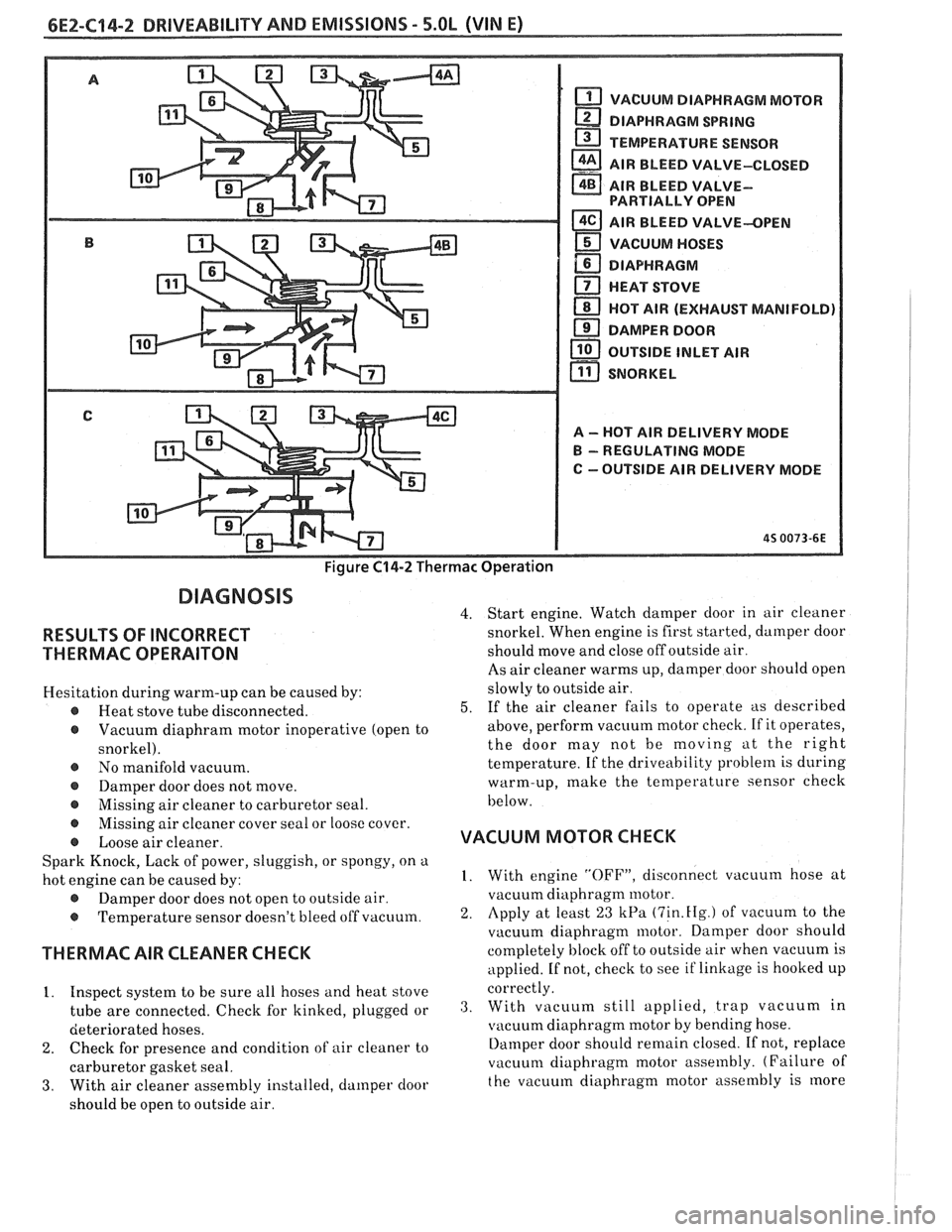
6E2-C14-2 DRIVEABILITY AND EMISSIONS - 5.OL (VIN E)
Figure C14-2 Thermac Operation
VACUUM DIAPHRAGM MOTOR
DIAPHRAGM
SPRING
TEMPERATURE SENSOR
a AIR BLEED VALVE-CLOSED - AIR BLEED VALVE- PARTIALLY OPEN
AIR BLEED VALVE-OPEN
VACUUM HOSES
DIAPHRAGM
a HEAT STOVE
HOT
AIR (EXHAUST MANIFOLD)
DAMPER
DOOR
OUTSIDE INLET AIR
11 SNORKEL r"l
A - HOT AIR DELIVERY MODE
B - REGULATING MODE
C
--OUTSIDE AIR DELIVERY MODE
DIAGNOSIS
4.
RESULTS OF INCORRECT
THERMAC OPERAITON
Hesitation during warm-up can be caused by:
r Heat stove tube disconnected. 5.
r Vacuum diaphram motor inoperative (open to
snorkel).
@ No manifold vacuum.
Damper door does not move.
Missing air cleaner to carburetor seal. Start
engine. Watch damper door in air cleaner
snorkel. When engine is first started, damper door
should move and close off outside air.
As air cleaner warms up, damper door should open
slowly to outside air.
If the air cleaner fails to operate as described
above, perform vacuum motor check. If it operates,
the door may not be moving
at the right
temperature. If the driveability
problem is during
warm-up, make the temperature sensor check
below.
- @ Missing air cleaner cover seal or loose cover.
r Loose air cleaner. VACUUM MOTOR CHECK
Spark Knock, Lack of power, sluggish, or spongy, on a
hot engine can be caused by: I. With engine "OFF", disconnect vacuum hose at
@ Damper door does not open to outside air. vacuum
diaphragm motor.
@ Temperature sensor doesn't bleed off vacuum. 2. Apply at least 23 kPa (7in.fIg.) of vacuum to the
vacuum diaphragm motor. Damper door should
THERMAC AIR CLEANER CHECK completely block off to outside air when vacuum is
applied. If not, check to see if linkage is hooked up
. .
1. Inspect system to be sure all hoses and heat stove correctly.
tube are connected. Check for kinked, plugged or 3. With vacllum still applied, trap Vacuum in
deteriorated
hoses. vitcuum diaphragm motor by bending hose.
2. Check for presence and condition of air cleaner to Ilarnper door should remain closed. If not, replace
carburetor gasket seal. vacuum
diaphragm motor assembly. (Failure of
3. With air cleaner assembly installecl, damper door the
vacuum diaphragm motor assembly is more
should be open to outside air.
Page 640 of 1825

DRIVEABILITY AND EMISSIONS - 5.OL (VIN E) 6EZ-C14-3
likely to be caused from binding linkage or a
corroded snorkel than from a failed diaphragm.
This should be checked first, before replacing the
diaphragm.)
4. If vacuum motor checks OK, check vacuum hoses
and connections. If OK, replace the temperature
sensor.
TEMPERATURE SENSOR CHECK
1. Start
test with air cleaner temperature below 30°C
(86°F). If engine has been run recently, remove air
cleaner cover and place thermometer as close as
possible to the sensor. Let air cleaner cool until
thermometer reads below 30°C
(86°F) about 5 to 10
minutes. Reinstall air cleaner on engine and
continue to Step
2.
2. Start and idle engine. Damper door should move to
close off outside air immediately if engine is cool
enough. When damper door starts to open the
snorkel passage (in a few minutes), remove air
cleaner cover and read thermometer. It must read
about
55°C (131°F).
3. If
the damper door is not open to outside air at
temperature indicated, temperature sensor is
malfunctioning and must be replaced.
OM-CAR SERVICE
AIR CLEANER ELEMENT
Remove or Disconnect
1. Air cleaner cover.
2. Old element.
Install or Connect
1. New element.
2. Air cleaner
cover. Do not over-torque nuts (install
finger- tight).
i
VACUUM DIAPHRAGM MOTOR
~emove or Disconnect
1. Air cleaner.
2. Vacuum hose from motor.
3. Drill out the two spot welds initially with a 1.
6mm (1116") drill, then enlarge as required to
remove the retaining strap. Do not damage the
snorkel tube.
4. Motor retaining strap.
5. Lift up motor, cocking it to one side to unhook the
motor linkage at the control damper assembly.
MOTOR ASM.
I 1 RETAINING STRAP - I
Figure C14-3 - Replacing THERMAC Vacuum Motor
Install or Connect
1. Drill a 2.8mm (7164") hole in snorkel tube at
center of vacuum motor retaining strap.
2. Vacuum motor linkage into control damper
assembly.
3. Use the motor retaining strap and sheet metal
screw provided in the motor service package to
secure motor to the snorkel tube. Make sure the
screw does not interfere with the operation of the
damper assembly. Shorten screw if required.
4. Vacuum
hose to motor and install air cleaner.
SENSOR
n Remove or Disconnect
1. Air cleaner.
2. Hoses at sensor.
3. Pry
up tabs
on sensor retaining clip. Remove clip
and sensor from air cleaner. Note position
of
sensor for installation.
Install or Connect
1. Sensor and gasket assembly in original position.
2. Retainer clip on hose connectors.
3. Vacuum hoses and air cleaner on engine.
Page 641 of 1825

6EZ-C"B4-4 DRIVEABILITY AND EMISSIONS - 5.OL (VIN E)
Figure C14-4 - Replacing THERMAC Sensor
PART NAME GROUP
Sensor, A/C . . . . . . . . . . . . . . . . . . . . . . . . . . 3.415
Motor,A/CVacDiaph.. . . . . . . . . . . . . . . . . . 3.415